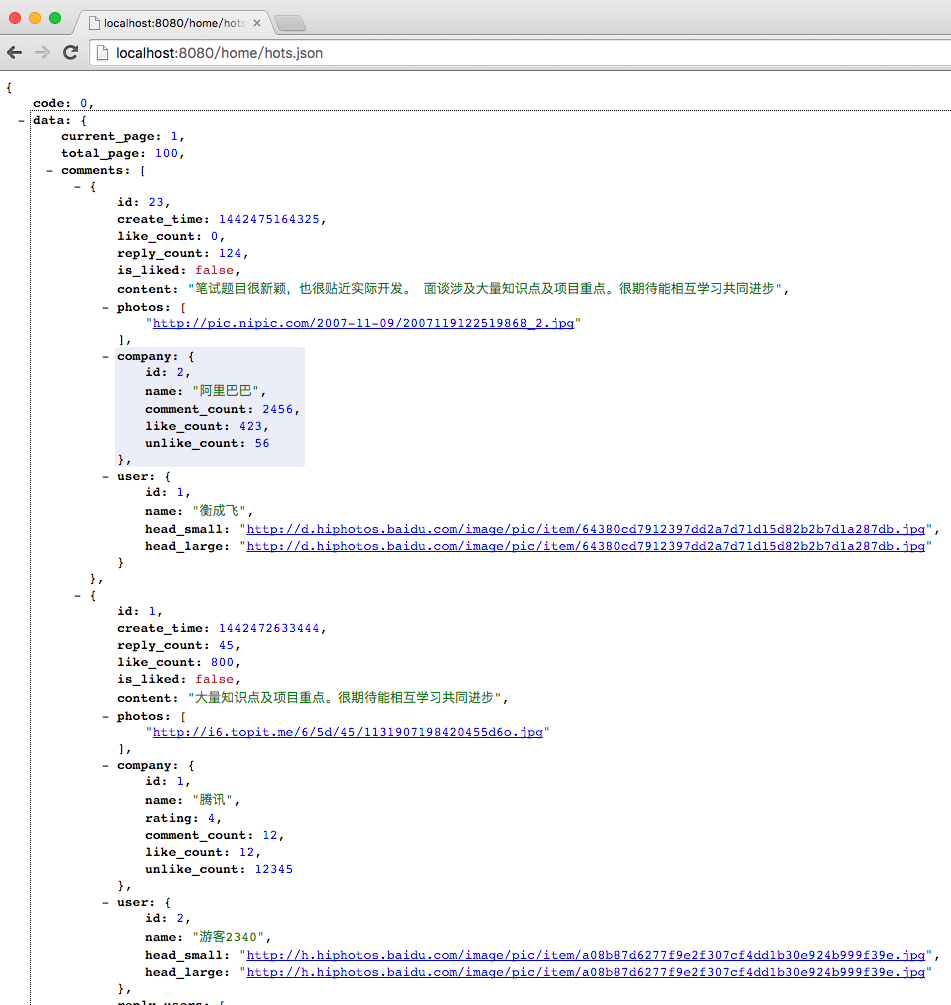RACSignal的Subscription深入分析
ReactiveCocoa是一個FRP的思想在Objective-C中的實現框架,目前在美團的項目中被廣泛使用。對於ReactiveCocoa的基本用法,網上有很多相關的資料,本文不再討論。RACSignal是ReactiveCocoa中一個非常重要的概念,而本文主要關注RACSignal的實現原理。在閱讀之前,你需要基本掌握RACSignal的基本用法。
本文主要包含2個部分,前半部分主要分析RACSignal的subscription過程,後半部分是對前半部分的深入,在subscription過程的基礎上分析ReactiveCocoa中比較難理解的兩個操作:multicast && replay。
PS:為了解釋清楚,我們下面只討論next,不討論error以及completed,這二者與next類似。本文基於ReactiveCocoa 2.x版本。
我們先刨析RACSignal的subscription過程
RACSignal的常見用法
-(RACSignal *)signInSignal {
// part 1:[RACSignal createSignal]來獲得signal
return [RACSignal createSignal:^RACDisposable *(id subscriber) {
[self.signInService
signInWithUsername:self.usernameTextField.text
password:self.passwordTextField.text
complete:^(BOOL success) {
// part 3: 進入didSubscribe,通過[subscriber sendNext:]來執行next block
[subscriber sendNext:@(success)];
[subscriber sendCompleted];
}];
return nil;
}];
}
// part 2 : [signal subscribeNext:]來獲得subscriber,然後進行subscription
[[self signInSignal] subscribeNext:^(id x) {
NSLog(@"Sign in result: %@", x);
}];Subscription過程概括
RACSignal的Subscription過程概括起來可以分為三個步驟:
[RACSignal createSignal]來獲得signal
[signal subscribeNext:]來獲得subscriber,然後進行subscription
進入didSubscribe,通過[subscriber sendNext:]來執行next block
步驟一:[RACSignal createSignal]來獲得signal
RACSignal.m中:
+ ( RACSignal *)createSignal:( RACDisposable * (^)( id < RACSubscriber > subscriber))didSubscribe {
return [ RACDynamicSignal createSignal :didSubscribe];
}
RACDynamicSignal.m中
+ ( RACSignal *)createSignal:( RACDisposable * (^)( id < RACSubscriber > subscriber))didSubscribe {
RACDynamicSignal *signal = [[ self alloc ] init ];
signal-> _didSubscribe = [didSubscribe copy ];
return [signal setNameWithFormat : @"+createSignal:" ];
}[RACSignal createSignal]會調用子類RACDynamicSignal的createSignal來返回一個signal,並在signal中保存後面的 didSubscribe這個block
步驟二:[signal subscribeNext:]來獲得subscriber,然後進行subscription
RACSignal.m中:
- ( RACDisposable *)subscribeNext:( void (^)( id x))nextBlock {
RACSubscriber *o = [ RACSubscriber subscriberWithNext :nextBlock error : NULL completed : NULL ];
return [ self subscribe :o];
}
RACSubscriber.m中:
+ ( instancetype )subscriberWithNext:( void (^)( id x))next error:( void (^)( NSError *error))error completed:( void (^)( void ))completed {
RACSubscriber *subscriber = [[ self alloc ] init ];
subscriber-> _next = [next copy ];
subscriber-> _error = [error copy ];
subscriber-> _completed = [completed copy ];
return subscriber;
}
RACDynamicSignal.m中:
- (RACDisposable *)subscribe:(id)subscriber {
RACCompoundDisposable *disposable = [RACCompoundDisposable compoundDisposable];
subscriber = [[RACPassthroughSubscriber alloc] initWithSubscriber:subscriber signal:self disposable:disposable];
if (self.didSubscribe != NULL) {
RACDisposable *schedulingDisposable = [RACScheduler.subscriptionScheduler schedule:^{
RACDisposable *innerDisposable = self.didSubscribe(subscriber);
[disposable addDisposable:innerDisposable];
}];
[disposable addDisposable:schedulingDisposable];
}
return disposable;
}[signal subscribeNext]先會獲得一個subscriber,這個subscriber中保存了nextBlock、errorBlock、completedBlock
由於這個signal其實是RACDynamicSignal類型的,這個[self subscribe]方法會調用步驟一中保存的didSubscribe,參數就是1中的subscriber
步驟三:進入didSubscribe,通過[subscriber sendNext:]來執行next block
RACSubscriber.m中:
- (void)sendNext:(id)value {
@synchronized (self) {
void (^nextBlock)(id) = [self.next copy];
if (nextBlock == nil) return;
nextBlock(value);
}
}任何時候這個[subscriber sendNext:],就直接調用nextBlock
signal的subscription過程回顧
從上面的三個步驟,我們看出:
先通過createSignal和subscribeNext這兩個調用,聲明了流中value到來時的處理方式
didSubscribe block塊中異步處理完畢之後,subscriber進行sendNext,自動處理
搞清楚了RAC的subscription過程,接著在此基礎上我們討論一個RACSignal中比較容易混淆的兩個操作:multicast和replay。
為什麼要清楚這兩者的原理
RACSignal+Operation.h中 - (RACMulticastConnection *)publish; - (RACMulticastConnection *)multicast:(RACSubject *)subject; - (RACSignal *)replay; - (RACSignal *)replayLast; - (RACSignal *)replayLazily;
在RACSignal+Operation.h中,連續定義了5個跟我們這個主題有關的RACSignal的操作,這幾個操作的區別很細微,但用錯的話很容易出問題。只有理解了原理之後,才明白它們之間的細微區別
很多時候我們意識不到需要用這些操作,這就可能因為side effects執行多次而導致程序bug
multicast && replay的應用場景
"Side effects occur for each subscription by default, but there are certain situations where side effects should only occur once – for example, a network request typically should not be repeated when a new subscriber is added."
// 引用ReactiveCocoa源碼的Documentation目錄下的一個例子
// This signal starts a new request on each subscription.
RACSignal *networkRequest = [RACSignal createSignal:^(id subscriber) {
AFHTTPRequestOperation *operation = [client
HTTPRequestOperationWithRequest:request
success:^(AFHTTPRequestOperation *operation, id response) {
[subscriber sendNext:response];
[subscriber sendCompleted];
}
failure:^(AFHTTPRequestOperation *operation, NSError *error) {
[subscriber sendError:error];
}];
[client enqueueHTTPRequestOperation:operation];
return [RACDisposable disposableWithBlock:^{
[operation cancel];
}];
}];
// Starts a single request, no matter how many subscriptions `connection.signal`
// gets. This is equivalent to the -replay operator, or similar to
// +startEagerlyWithScheduler:block:.
RACMulticastConnection *connection = [networkRequest multicast:[RACReplaySubject subject]];
[connection connect];
[connection.signal subscribeNext:^(id response) {
NSLog(@"subscriber one: %@", response);
}];
[connection.signal subscribeNext:^(id response) {
NSLog(@"subscriber two: %@", response);
}];在上面的例子中,如果我們不用RACMulticastConnection的話,那就會因為執行了兩次subscription而導致發了兩次網絡請求。
從上面的例子中,我們可以看到對一個Signal進行multicast之後,我們是對connection.signal進行subscription而不是原來的networkRequest。這點是"side effects should only occur once"的關鍵,我們將在後面解釋
multicast原理分析
replay是multicast的一個特殊case而已,而multicast的整個過程可以拆分成兩個步驟,下面進行詳細討論
multicast的機制Part 1:
RACMulticastConnection.m中:
- (id)initWithSourceSignal:(RACSignal *)source subject:(RACSubject *)subject {
NSCParameterAssert(source != nil);
NSCParameterAssert(subject != nil);
self = [super init];
if (self == nil) return nil;
_sourceSignal = source;
_serialDisposable = [[RACSerialDisposable alloc] init];
_signal = subject;
return self;
}結合上面的例子來看,RACMulticastConnection的init是以networkRequest作為sourceSignal,而最終connnection.signal指的是[RACReplaySubject subject]
RACMulticastConnection.m中:
- (RACDisposable *)connect {
BOOL shouldConnect = OSAtomicCompareAndSwap32Barrier(0, 1, &_hasConnected);
if (shouldConnect) {
self.serialDisposable.disposable = [self.sourceSignal subscribe:_signal];
}
return self.serialDisposable;
}結合上面的RACSignal分析的Subscription過程,[self.sourceSignal subscribe:_signal]會執行self.sourceSignal的didSubscribe這個block。再結合上面的例子,也就是說會把_signal作為subscriber,發網絡請求,success的時候,_signal會sendNext,這裡的這個signal就是[RACReplaySubject subject]。可以看出,一旦進入到這個didSubscribe中,後續的不管是sendNext還是subscription,都是對這個[RACReplaySubject subject]進行的,與原來的sourceSignal徹底無關了。這就解釋了為什麼"side effects only occur once"。
multicast的機制Part 2:
在進行multicast的步驟二之前,需要介紹一下RACSubject以及RACReplaySubject
---------------------惱人的分隔線 start------------------
RACSubject
"A subject can be thought of as a signal that you can manually control by sending next, completed, and error."
RACSubject的一個用法如下:
RACSubject *letters = [RACSubject subject];
// Outputs: A B
[letters subscribeNext:^(id x) {
NSLog(@"%@ ", x);
}];
[letters sendNext:@"A"];
[letters sendNext:@"B"];接下來分析RACSubject的原理
RACSubject.m中:
- (id)init {
self = [super init];
if (self == nil) return nil;
_disposable = [RACCompoundDisposable compoundDisposable];
_subscribers = [[NSMutableArray alloc] initWithCapacity:1];
return self;
}RACSubject中有一個subscribers數組
RACSubject.m中:
- (RACDisposable *)subscribe:(id)subscriber {
NSCParameterAssert(subscriber != nil);
RACCompoundDisposable *disposable = [RACCompoundDisposable compoundDisposable];
subscriber = [[RACPassthroughSubscriber alloc] initWithSubscriber:subscriber signal:self disposable:disposable];
NSMutableArray *subscribers = self.subscribers;
@synchronized (subscribers) {
[subscribers addObject:subscriber];
}
return [RACDisposable disposableWithBlock:^{
@synchronized (subscribers) {
// Since newer subscribers are generally shorter-lived, search
// starting from the end of the list.
NSUInteger index = [subscribers indexOfObjectWithOptions:NSEnumerationReverse passingTest:^ BOOL (id obj, NSUInteger index, BOOL *stop) {
return obj == subscriber;
}];
if (index != NSNotFound) [subscribers removeObjectAtIndex:index];
}
}];
}從subscribe:的實現可以看出,對RACSubject對象的每次subscription,都是將這個subscriber加到subscribers數組中而已
RACSubject.m中:
- (void)sendNext:(id)value {
[self enumerateSubscribersUsingBlock:^(id subscriber) {
[subscriber sendNext:value];
}];
}從sendNext:的實現可以看出,每次RACSubject對象sendNext,都會對其中保留的subscribers進行sendNext,如果這個subscriber是RACSignal的話,就會執行Signal的next block。
RACReplaySubject
"A replay subject saves the values it is sent (up to its defined capacity) and resends those to new subscribers.",可以看出,replaySubject是可以對它send next(error,completed)的東西進行buffer的。
RACReplaySubject是繼承自RACSubject的,它的內部的實現例如subscribe:、sendNext:的實現也會調用super的實現
RACReplaySubject.m中:
- (instancetype)initWithCapacity:(NSUInteger)capacity {
self = [super init];
if (self == nil) return nil;
_capacity = capacity;
_valuesReceived = (capacity == RACReplaySubjectUnlimitedCapacity ? [NSMutableArray array] : [NSMutableArray arrayWithCapacity:capacity]);
return self;
}從init中我們看出,RACReplaySubject對象持有capacity變量(用於決定valuesReceived緩存多少個sendNext:出來的value,這在區分replay和replayLast的時候特別有用)以及valuesReceived數組(用來保存sendNext:出來的value),這二者接下來會重點涉及到
RACReplaySubject.m中:
- (RACDisposable *)subscribe:(id)subscriber {
RACCompoundDisposable *compoundDisposable = [RACCompoundDisposable compoundDisposable];
RACDisposable *schedulingDisposable = [RACScheduler.subscriptionScheduler schedule:^{
@synchronized (self) {
for (id value in self.valuesReceived) {
if (compoundDisposable.disposed) return;
[subscriber sendNext:(value == RACTupleNil.tupleNil ? nil : value)];
}
if (compoundDisposable.disposed) return;
if (self.hasCompleted) {
[subscriber sendCompleted];
} else if (self.hasError) {
[subscriber sendError:self.error];
} else {
RACDisposable *subscriptionDisposable = [super subscribe:subscriber];
[compoundDisposable addDisposable:subscriptionDisposable];
}
}
}];
[compoundDisposable addDisposable:schedulingDisposable];
return compoundDisposable;
}從subscribe:可以看出,RACReplaySubject對象每次subscription,都會把之前valuesReceived中buffer的value重新sendNext一遍,然後調用super把當前的subscriber加入到subscribers數組中
RACReplaySubject.m中:
- (void)sendNext:(id)value {
@synchronized (self) {
[self.valuesReceived addObject:value ?: RACTupleNil.tupleNil];
[super sendNext:value];
if (self.capacity != RACReplaySubjectUnlimitedCapacity && self.valuesReceived.count > self.capacity) {
[self.valuesReceived removeObjectsInRange:NSMakeRange(0, self.valuesReceived.count - self.capacity)];
}
}
}從sendNext:可以看出,RACReplaySubject對象會buffer每次sendNext的value,然後會調用super,對subscribers中的每個subscriber,調用sendNext。buffer的數量是根據self.capacity來決定的
---------------------惱人的分隔線 end------------------
介紹完了RACReplaySubject之後,我們繼續進行multicast的part 2部分。
在上面的例子中,我們對connection.signal進行了兩次subscription,結合上面的RACReplaySubject的subscription的subscribe:,我們得到以下過程:
[RACReplaySubject subject]會將這兩次subscription過程中的subscriber都保存在subscribers數組中
當網絡請求success後,會[subscriber sendNext:response],前面已經講過這個subscriber就是[RACReplaySubject subject],這樣,就會把sendNext:的value保存在valuesReceived數組中,供後續subscription使用(不知道你是否注意到RACReplaySubject的subscribe:中有個for循環),然後對subscribers中保存的每個subscriber執行sendNext。
後續思考
上面討論的是RACReplaySubject對象先進行subscription,再進行sendNext,如果是先sendNext,再subscription呢?其實魅力就在於RACReplaySubject的subscribe:中的for循環。具體過程留作思考
在RACSignal+Operation中關於multicast && replay的,一共有5個操作:publish、multicast、replay、replayLast、replayLazily,他們之間有什麼細微的差別呢?相信在我上面內容的基礎上,他們之間的細微差別不難理解,這裡推薦一篇幫助大家理解的blog
參考資料
ReactiveCocoa github主頁
ReactiveCocoa Documentation
ReactiveCocoa raywenderlich上的資料
- Mac Android Studio快捷鍵整頓
- iOS10語音辨認框架SpeechFramework運用詳解
- iOS10 App適配權限 Push Notifications 字體Frame 碰到的成績
- iOS10適配之權限Crash成績的完善處理計劃
- iOS突變圓環扭轉動畫CAShapeLayer CAGradientLayer
- Mac下獲得AppStore裝置包文件途徑
- React Native搭建iOS開辟情況
- IOS上iframe的轉動條掉效的處理方法
- iOS法式開辟之應用PlaceholderImageView完成優雅的圖片加載後果
- iOS中NSArray數組經常使用處置方法
- iOS制造framework靜態庫圖文教程
- Android中getActivity()為null的處理方法
- iOS App開辟中的UIStackView堆疊視圖應用教程
- IOS代碼筆記UIView的placeholder的後果
- 實例講授iOS中的CATransition轉場動畫應用




